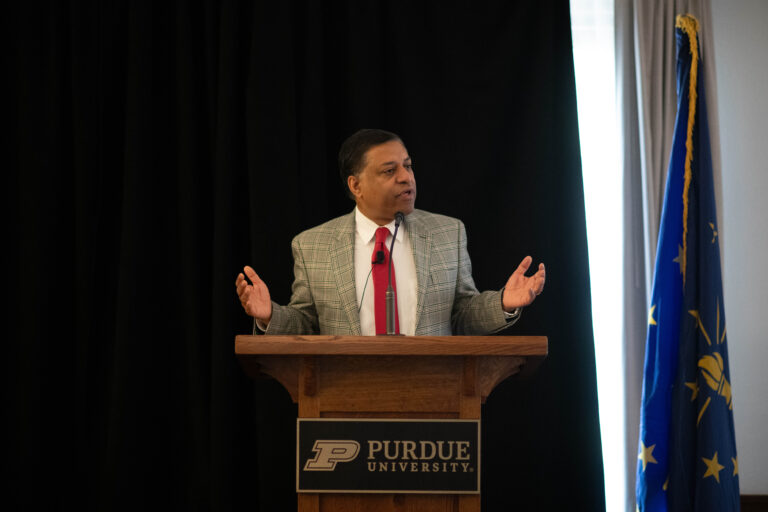More than 100,000 people died of an opioid overdose nationwide in 2022 and more than two-thirds of those deaths involved synthetic opioids.
Synthetic opioids are substances that are synthesized in a laboratory and act on the same targets in the brain as natural opioids to reduce pain. In contrast, natural opioids — including heroin, morphine, and codeine — are naturally occurring substances extracted from the seed pod of certain varieties of poppy plants.
Fentanyl is the most commonly used synthetic opioid. Recently, other synthetic drugs have cropped up in the opioid supply like xylazine, a horse tranquilizer not approved for human use and with no known antidote. In humans, the drug can cause deep flesh wounds.
“We are in the midst of a synthetic drug crisis in addition to what we call organic drugs,” said Dr. Rahul Gupta, White House Director of Office of National Drug Control Policy (ONDCP), during a recent visit to Purdue University in Indiana.
“Now, in the closet, you can have a student with a chemistry set and internet and could create some of the most dangerous drugs ever known to humankind,” added Gupta.
State departments of health across the region have taken some action and issued advisories as the synthetic drug-involved overdose death toll has risen in recent years.
Gov. Mike DeWine of Ohio signed an executive order earlier this year classifying xylazine as a controlled substance.
"This lethal drug has dangerous side effects which can’t be reversed by naloxone, so there is no way to reverse its impact on people,” said Gov. DeWine. “The rate of overdose deaths involving a mixture of xylazine and other drugs is increasing at an alarming rate, which is exactly why we need to take action now."
According to the Missouri Department of Health and Seniors Services, synthetic opioids were behind more than 1,200 drug overdose deaths in 2020 in the state –– “nearly seven times higher than the 2015 count of 179 synthetic opioid-involved deaths,” the department said.
The Indiana Department of Health recently put out an alert about another emerging drug called bromazolam. It was created for medicinal purposes in the 1970s but was never approved for use in the U.S. Bromazolam is not an opioid but is frequently mixed with opioids such as fentanyl.
The drug can be sold as tablets, powders and gummies. It is often sold as “XLI-268,” “Xanax,” “Fake Xanax,” and “Dope.”
Fentanyl laced with drugs like xylazine and bromazolam can be extremely dangerous.
Kansas has seen a 790% increase in synthetic opioid-related overdose deaths over the 10-year period from 2012 to 2021, according to a joint testimony from the Kansas Department of Health and Environment and the Kansas Department for Aging and Disability Services earlier this year.
“Overdose deaths identified among Kansas residents involving a synthetic opioid have more than doubled each year for the past two years of available data – from 70 in 2019 to 161 in 2020, and then to 347 in 2021,” according to the testimony.
Gupta says when people order Xanax or Adderall online, they often get counterfeit pills. The likelihood of counterfeit pills having potentially lethal doses of fentanyl is 6 out of 10.
He also stressed the importance of Naloxone, a medication that is used to reverse an opioid overdose effectively. Naloxone was approved by the U.S. Food and Drug Administration to be available over the counter earlier this year.
Gupta recommends schools, governments, and businesses make Naloxone readily available. He also recommends that everyone should carry Naloxone if they can.
Naloxone is a key aspect of evidence-based approaches to adverse consequences of drug use, also known as harm reduction for substance use disorders. Other harm reduction methods include drug testing and syringe service programs.
For the first time ever, harm reduction has been adopted as a Federal Policy. The Biden Administration released its inaugural National Drug Control Strategy in 2022. The strategy calls for greater access to harm reduction interventions including naloxone, drug test strips, and syringe services programs.
Contact reporter Alex Li at ali@wfyi.org.
Side Effects Public Media is a health reporting collaboration based at WFYI in Indianapolis. We partner with NPR stations across the Midwest and surrounding areas — including KBIA and KCUR in Missouri, Iowa Public Radio, Ideastream in Ohio and WFPL in Kentucky.
9(MDM5MjE5NTg1MDE1Mjk1MTM5NjlkMzI1ZQ000))

